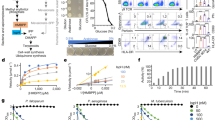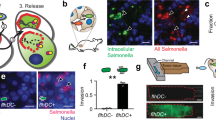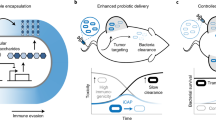Abstract
Necrosis is a typical histological feature of solid tumours that provides a selective environment for growth of the non-pathogenic anaerobic bacterium Clostridium sporogenes. Modest anti-tumour activity as a single agent encouraged the use of C. sporogenes as a vector to express therapeutic genes selectively in tumour tissue, a concept termed Clostridium Directed Enzyme Prodrug Therapy (CDEPT). Here, we examine the ability of a recently identified Neisseria meningitidis type I nitroreductase (NmeNTR) to metabolise the prodrug PR-104A in an in vivo model of CDEPT. Human HCT116 colon cancer cells stably over-expressing NmeNTR demonstrated significant sensitivity to PR-104A, the imaging agent EF5, and several nitro(hetero)cyclic anti-infective compounds. Chemical induction of necrosis in human H1299 xenografts by the vascular disrupting agent vadimezan promoted colonisation by NmeNTR-expressing C. sporogenes, and efficacy studies demonstrated moderate but significant anti-tumour activity of spores when compared to untreated controls. Inclusion of the pre-prodrug PR-104 into the treatment schedule provided significant additional activity, indicating proof-of-principle. Successful preclinical evaluation of a transferable gene that enables metabolism of both PET imaging agents (for vector visualisation) and prodrugs (for conditional enhancement of efficacy) is an important step towards the prospect of CDEPT entering clinical evaluation.
This is a preview of subscription content, access via your institution
Access options
Subscribe to this journal
Receive 12 print issues and online access
$259.00 per year
only $21.58 per issue
Buy this article
- Purchase on Springer Link
- Instant access to full article PDF
Prices may be subject to local taxes which are calculated during checkout






Similar content being viewed by others
References
Richards CH, Mohammed Z, Qayyum T, Horgan PG, McMillan DC. The prognostic value of histological tumour necrosis in solid organ malignant disease: a systematic review. Future Oncol. 2011;7:1223–35.
Mose JR, Mose G. Activity of Clostridium butyricum (M-55) and other non pathogenic clostridia against the Erlich carcinoma. Cancer Res. 1964;24:212–6.
Minton NP, Mauchline ML, Lemmon MJ, Brehm JK, Fox M, Michael NP, et al. Chemotherapeutic tumour targeting using clostridial spores. FEMS Microbiol Rev. 1995;17:357–64.
Liu SC, Minton NP, Giaccia AJ, Brown JM. Anticancer efficacy of systemically delivered anaerobic bacteria as gene therapy vectors targeting tumor hypoxia/necrosis. Gene Ther. 2002;9:291–6.
Liu SC, Ahn GO, Kioi M, Dorie MJ, Patterson AV, Brown JM. Optimized clostridium-directed enzyme prodrug therapy improves the antitumor activity of the novel DNA cross-linking agent PR-104. Cancer Res. 2008;68:7995–8003.
Theys J, Pennington O, Dubois L, Anlezark G, Vaughan T, Mengesha A, et al. Repeated cycles of Clostridium-directed enzyme prodrug therapy result in sustained antitumour effects in vivo. Br J Cancer. 2006;95:1212–9.
Heap JT, Pennington OJ, Cartman ST, Minton NP. A modular system for Clostridium shuttle plasmids. J Microbiol Methods. 2009;78:79–85.
Keese P. Risks from GMOs due to horizontal gene transfer. Environ Biosaf Res. 2008;7:123–49.
Heap JT, Ehsaan M, Cooksley CM, Ng YK, Cartman ST, Winzer K, et al. Integration of DNA into bacterial chromosomes from plasmids without a counter-selection marker. Nucleic Acids Res. 2012;40:e59.
Heap JT, Theys J, Ehsaan M, Kubiak AM, Dubois L, Paesmans K, et al. Spores of Clostridium engineered for clinical efficacy and safety cause regression and cure of tumours in vivo. Oncotarget. 2014;5:1761–9.
Helsby NA, Ferry DM, Patterson AV, Pullen SM, Wilson WR. 2-Amino metabolites are key mediators of CB 1954 and SN 23862 bystander effects in nitroreductase GDEPT. Br J Cancer. 2004;90:1084–92.
Wilson WR, Pullen SM, Hogg A, Helsby NA, Hicks KO, Denny WA. Quantitation of bystander effects in nitroreductase suicide gene therapy using three-dimensional cell cultures. Cancer Res. 2002;62:1425–32.
Patterson AV, Ferry DM, Edmunds SJ, Gu Y, Singleton RS, Patel K, et al. Mechanism of action and preclinical antitumor activity of the novel hypoxia-activated DNA crosslinking agent PR-104. Clin Cancer Res. 2007;13:3922–32.
Singleton DC, Li D, Bai SY, Syddall SP, Smaill JB, Shen Y, et al. The nitroreductase prodrug SN 28343 enhances the potency of systemically administered armed oncolytic adenovirus ONYX-411(NTR). Cancer Gene Ther. 2007;14:953–67.
Wilson WR, Hicks KO, Pullen SM, Ferry DM, Helsby NA, Patterson AV. Bystander effects of bioreductive drugs: potential for exploiting pathological tumor hypoxia with dinitrobenzamide mustards. Radiat Res. 2007;167:625–36.
Gu Y, Patterson AV, Atwell GJ, Chernikova SB, Brown JM, Thompson LH, et al. Roles of DNA repair and reductase activity in the cytotoxicity of the hypoxia-activated dinitrobenzamide mustard PR-104A. Mol Cancer Therapeutics. 2009;8:1714–23.
Prosser GA, Copp JN, Mowday AM, Guise CP, Syddall SP, Williams EM, et al. Creation and screening of a multi-family bacterial oxidoreductase library to discover novel nitroreductases that efficiently activate the bioreductive prodrugs CB 1954 and PR-104A. Biochemical Pharmacol. 2013;85:1091–103.
Yang S, Atwell GJ, Denny WA. Synthesis of asymmetric halomesylate mustards with aziridineethanol/alkali metal halides: application to an improved synthesis of the hypoxia prodrug PR-104. Tetrahedron. 2007;63:5470–6.
Atwell GJ, Denny WA. Synthesis of 3H and 2H4-labelled versions of the hypoxia-activated pre-prodrug 2-[(2-bromoethyl)-2,4-dinitro-6-[[[2-(phosphonooxy)ethyl]amino]carbonyl]anilino]ethyl methanesulfonate (PR-104). J Label Compd Radiopharm. 2007;50:7–12.
Atwell GJ, Yang S, Denny WA. An improved synthesis of 5,6-dimethylxanthenone-4-acetic acid (DMXAA). Eur J Medicinal Chem. 2002;37:852–8.
Su J, Guise CP, Wilson WR. FSL-61 is a 6-nitroquinolone fluorogenic probe for one-electron reductases in hypoxic cells. Biochemical J. 2013;452:79–86.
Jin C-Z, Nagasawa H, Shimamura M, Uto Y, Inayama S, Takeuchi Y, et al. Angiogenesis inhibitor TX-1898: syntheses of the enantiomers of sterically diverse haloacetylcarbamoyl-2-nitroimidazole hypoxic cell radiosensitizers. Bioorg Med Chem. 2004;12:4917–27.
Copp JN, Mowday AM, Williams EM, Guise CP, Ashoorzadeh A, Sharrock AV, et al. Engineering a multifunctional nitroreductase for improved activation of prodrugs and PET probes for cancer gene therapy. Cell Chem Biol. 2017;24:391–403.
Prosser GA, Copp JN, Syddall SP, Williams EM, Smaill JB, Wilson WR, et al. Discovery and evaluation of Escherichia coli nitroreductases that activate the anticancer prodrug CB 1954. Biochem Pharmacol. 2010;79:678–87.
Helsby NA, Atwell GJ, Yang S. Aziridinyldinitrobenzamides: synthesis and structure-activity relationships for activation by E. coli nitroreductase. J Medicinal Chem. 2004;47:3295–307.
Koch CJ. Importance of antibody concentration in the assessment of cellular hypoxia by flow cytometry: EF5 and pimonidazole. Radiat Res. 2008;169:677–88.
Heap JT, Kuehne SA, Ehsaan M, Cartman ST, Cooksley CM, Scott JC, et al. The ClosTron: mutagenesis in Clostridium refined and streamlined. J Microbiol Methods. 2010;80:49–55.
Knox RJ, Boland MP, Friedlos F, Coles B, Southan C, Roberts JJ. The nitroreductase enzyme in Walker cells that activates 5-(aziridin-1-yl)-2,4-dinitrobenzamide (CB 1954) to 5-(aziridin-1-yl)-4-hydroxylamino-2-nitrobenzamide is a form of NAD(P)H dehydrogenase (quinone) (EC 1.6.99.2). Biochem Pharm. 1988;37:4671–7.
Heap JT, Pennington OJ, Cartman ST, Carter GP, Minton NP. The ClosTron: a universal gene knock-out system for the genus Clostridium. J Microbiol Methods. 2007;70:452–64.
Schindelin J, Arganda-Carreras I, Frise E, Kaynig V, Longair M, Pietzsch T, et al. Fiji: an open-source platform for biological-image analysis. Nat Methods. 2012;9:676–82.
Therasse P, Arbuck SG, Eisenhauer EA, Wanders J, Kaplan RS, Rubinstein L, et al. New guidelines to evaluate the response to treatment in solid tumours. J Natl Cancer Inst. 2000;92:205–16.
Mowday AM, Copp JN, Syddall SP, Dubois LJ, Wang J, Lieuwes NG, et al. E. coli nitroreductase NfsA is a reporter gene for non-invasive PET imaging in cancer gene therapy applications. Theranostics. 2020;10:10548–62.
Serganova I, Blasberg RG. Molecular imaging with reporter genes: has its promise been delivered? J Nucl Med. 2019;60:1665–81.
Koch CJ, Hahn SM, Rockwell JrK, Covery JM, McKenna WG, Evans SM. Pharmacokinetics of EF5 [2-(2-nitro-1-H-imidazol-1-yl)-N-(2,2,3,3,3-pentafluoropropyl)acetamide] in human patients: implications for hypoxia measurements in vivo by 2-nitroimidazoles. Cancer Chemother Pharmacol. 2001;48:177–87.
Baguley BC, Wilson WR. Potential of DMXAA combination therapy for solid tumors. Expert Rev Anticancer Ther. 2002;2:593–603.
Zwi LJ, Baguley BC, Gavin JB, Wilson WR. The morphological effects of the anti-tumor agents flavone acetic acid and 5,6-dimethyl xanthenone acetic acid on the colon 38 mouse tumor. Pathology (Phila, Pa). 1994;26:161–9.
Dang LH, Bettegowda C, Huso DL, Kinzler KW, Vogelstein B. Combination bacteriolytic therapy for the treatment of experimental tumors. Proc Natl Acad Sci (USA). 2001;98:15155–60.
Theys J, Landuyt W, Nuyts S, van Mellaert L, Bosmans E, Rijnders A, et al. Improvement of Clostridium tumour targeting vectors evaluated in rat rhabdomyosarcomas. FEMS Immunol Med Microbiol. 2001;30:37–41.
Divine MR, Katiyar P, Kohlhofer U, Quintanilla-Martinez L, Pichler BJ, Disselhorst JA. A population-based gaussian mixture model incorporating 18F-FDG PET and diffusion-weighted MRI quantifies tumor tissue classes. J Nucl Med. 2016;57:473–9.
Beddy P, Genega EM, Ngo L, Hindman N, Wei J, Bullock A, et al. Tumor necrosis on magnetic resonance imaging correlates with aggressive histology and disease progression in clear cell renal cell carcinoma. Clin Genitourin Cancer. 2014;12:55–62.
Egeland TA, Gaustad JV, Galappathi K, Rofstad EK. Magnetic resonance imaging of tumor necrosis. Acta Oncol. 2011;50:427–34.
Mowday AM, Guise CP, Ackerley DF, Minton NP, Lambin P, Dubois L, et al. Advancing Clostridia to clinical trial: past lessons and recent progress. Cancers. 2016;8:63–76.
Xu K, Wang F, Pan X, Liu R, Ma J, Konga F, et al. High selectivity imaging of nitroreductase using a near-infrared fluorescence probe in hypoxic tumour. Chem Commun. 2013;49:2554–6.
Li Z, He X, Wang Z, Yang R, Shi W, Ma H. In vivo imaging and detection of nitroreductase in zebrafish by a new near-infrared fluorescence on-off probe. Biosens Bioelectron. 2015;63:112–6.
Thorne SH, Barak Y, Liang W, Bachmann MH, Rao J, Contag CH, et al. CNOB/ChrR6, a new prodrug enzyme cancer chemotherapy. Mol Cancer Therapeutics. 2009;8:333–41.
Ntziachristos V, Ripoli J, Weissleder R. Would near-infrared fluorescence signals propagate through large human organs for clinical studies? Opt Lett. 2002;27:527–9.
Acknowledgements
This work was funded by the Health Research Council of New Zealand (Grant 14/289), the ZonMW TGO program (Grant 43400009), the Dutch Cancer Society (KWF Alpe d’HuZes Unieke Kansen #8025), the UK Biotechnology and Biological Sciences Research Council (BBSRC; grant number BB/L013940/1) and by a scholarship from the University of Auckland (awarded to AMM).
Author information
Authors and Affiliations
Contributions
AMM, AMK, CPG, DFA, PL, NPM, JBS and AVP conceived and designed the experiments; AMM, JVEC and AMK performed the experiments; AMM, LD, JVEC, AMK, JT and AVP analyzed the data; AA, JBS, NPM contributed reagents/materials/analysis tools; AMM, LD, JBS, JT and AVP wrote the paper; JVEC, AMK, CPG, AA, DFA, PL and NPM reviewed and edited the paper.
Corresponding author
Ethics declarations
Conflict of interest
The authors declare that they have no conflict of interest.
Additional information
Publisher’s note Springer Nature remains neutral with regard to jurisdictional claims in published maps and institutional affiliations.
Supplementary information
Rights and permissions
About this article
Cite this article
Mowday, A.M., Dubois, L.J., Kubiak, A.M. et al. Use of an optimised enzyme/prodrug combination for Clostridia directed enzyme prodrug therapy induces a significant growth delay in necrotic tumours. Cancer Gene Ther 29, 178–188 (2022). https://doi.org/10.1038/s41417-021-00296-7
Received:
Revised:
Accepted:
Published:
Issue Date:
DOI: https://doi.org/10.1038/s41417-021-00296-7
This article is cited by
-
Multiplex genetic manipulations in Clostridium butyricum and Clostridium sporogenes to secrete recombinant antigen proteins for oral-spore vaccination
Microbial Cell Factories (2024)
-
Clostridium Bacteria: Harnessing Tumour Necrosis for Targeted Gene Delivery
Molecular Diagnosis & Therapy (2024)
-
Bioreductive prodrug PR-104 improves the tumour distribution and titre of the nitroreductase-armed oncolytic adenovirus ONYX-411NTR leading to therapeutic benefit
Cancer Gene Therapy (2022)



